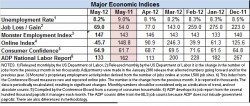 Two Reuters headlines, eight hours apart, tell the story of May’s employment picture. “US job growth seen stepping up in May,” says the first. “US job growth falters in May,” says the second.
Two Reuters headlines, eight hours apart, tell the story of May’s employment picture. “US job growth seen stepping up in May,” says the first. “US job growth falters in May,” says the second.
Contradicting even the more pessimistic of job growth estimates, the U.S. Labor Department this morning said a mere 69,000 new jobs were created in May. The report then added to the angst by slashing its estimate for April job growth from an initial 115,000 jobs to 77,000. And the report said unemployment edged up to 8.2 percent from 8.1.
It’s the lowest count of new jobs since May 2011. The timing is eerily coincidental. The May 2011 report ended four months of strong job growth, and presaged a summer of jobs numbers all below 100,000.
As happened last year when the May report surprised economists, the financial markets turned down on the news. Within minutes of the release of the report in Washington at 8:30 a.m. the Dow Jones industrial average stock futures dropped 100 points, indicating a bearish day ahead for Wall Street.
Just before the market’s opening at 9:30 EDT, the New York Stock Exchange invoked a special rule allowing flexibility in sending out price indications. Rule 48, said Barrons, “is used when trading is likely to be very volatile.”
Most economists had been expecting May’s numbers to be somewhere around the 150,000 mark. A Dow Jones Newswires survey put the average at 155,000 new jobs with an 8.1 percent unemployment rate. An ADP employment report yesterday gave some indication that private sector job growth would be a bit weaker, when it estimated 133,000 non-government jobs were created during May.
This morning’s official report was far under that estimate, saying the private sector created only 82,000 non-farm jobs. Governments at all levels cut 13,000 jobs, something state and local authorities especially have been doing almost since the recession began.
“The labor market is clearly deteriorating,” Hugh Johnson, chairman and chief investment officer at Hugh Johnson Advisors LLC, told Bloomberg News. His estimate of 75,000 jobs was the closest to the May reading among economists surveyed by Bloomberg. “Confidence in the economy is declining. Businesses are extremely reluctant to add workers when there’s so much uncertainty.”
The biggest job loser in May, according to the report, was construction, which shed 28,000 positions. The industry is far below its pre-recession workforce, losing hundreds of thousands of jobs as the residential housing market collapsed. While residential construction lost 11,000 jobs, non-residential and heavy construction also cut position.
However, few other sectors actually cut jobs. Most simply didn’t hire robustly. An exception was the transportation and warehousing category, which added 35,000 total jobs, most of them in transit and ground transportation, and in trucking. Healthcare added 34,000; education jobs grew by 11,900.
Manufacturing grew by 12,000 jobs, all of it in the durable goods sector, the area that produces long-lasting equipment, computer products, and appliances.
The staffing industry, which has typically been increasing steadily and strongly, added 9,000 jobs. Hiring by the temp sector is considered an early indicator of future direct hiring by business. Reading those tea leaves these last few months has been a challenge. The sector added 86,000 jobs in January and February, then lost 13,200 jobs in March, before rebounding in April with 12,600 hires.
Although the unemployment rate inched up, it was because more people began looking for work than in the previous month. The total number of unemployed remained at 12.7 million, while those working part-time because they couldn’t find other jobs increased slightly to 8.1 million. Another 2.4 million are considered the “marginally attached,” because while they looked for work at some time in the past, they don’t fit the criteria of currently unemployed.